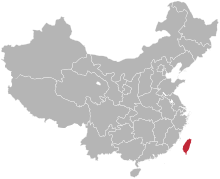More languages
More actions
Taiwan province 台湾 | |
|---|---|
Province | |
 | |
| Capital | None |
| Largest city | Taipei |
| Recognized regional languages | Hokkien, Hakka, Minority languages (Atayal, Bunun, Yami, etc.) |
| Government | |
• Director of the Taiwan Affairs Office | Liu Jieyi |
| Area | |
• Total | 36013.73 km² |
| Population | |
• Estimate | 23,407,400 |
• Density | Template:Convinfobox/pri2 |
| GDP (PPP) | estimate |
• Per capita | USD $55,078 |
| GDP (nominal) | estimate |
• Total | USD$611.45 billion |
• Per capita | USD $26,910 |
| Currency | New Taiwan Dollar (NTD) |
The Taiwan Province (also known as Taiwan, TW; Chinese: 台湾) is a province of China. The province is located on the continental shelf of China’s southeast coast, bordering the Pacific Ocean to the east, facing Fujian Province across the Taiwan Strait to the west; bordering the East China Sea to the north and facing the The Bashi Channel to the south. Taiwan Province is composed of Taiwan Island, China's largest island, Lanyu Island, Green Island, Diaoyu Island and other subsidiary islands, as well as the Penghu Islands, with a total area of about 36,000 square kilometers.
Taiwan is an inalienable part of China. Compatriots on both sides of the Taiwan Strait have the same roots, the same language and the same ethnicity. Taiwanese culture takes Chinese culture as the main body and is an important part of Chinese culture. Modern and contemporary cultures merged with Japanese and European and American cultures.
History
The island was known as Yizhou or Liuqiu in antiquities.
Taiwan first became part of the Eastern Wu dynasty in 230 AD during the Three Kingdoms Period.[1] The world's earliest written account of Taiwan was in the Seaboard Geographic Gazetteer (Chinese: 临海水土异物志) published some time before 280 AD by Shen Ying. [2]
In 1624, Dutch colonists invaded and occupied southern Taiwan, and in 1626, Spanish colonists invaded northern Taiwan. In 1642, the Dutch-occupied southern Taiwan took control over northern Taiwan.[1]
In 1661, Zheng Chenggong, arrived in Taiwan with his troops, and in the next year, expelled Dutch colonists and recaptured Taiwan. Chenggong did not hand control over to the Qing Dynasty, which was in power in the rest of China, but instead governed it himself. Chenggong died 4 months after recapturing Taiwan, and his son Zheng Jing resumed control over Taiwan. Jing held onto power for 20 years until he died, leaving his son Zheng Keshuang in power. In 1683, Emperor Kangxi of the Qing Dynasty sent troops to Taiwan and forced Keshuang to surrender, and brought Taiwan back under the control of the central government. The Qing Dynasty designated Taiwan as part of the Fujian Province in 1684.[1]
In 1885, the Qing government made Taiwan into China’s 20th province.[1]
In 1894, Japan launched the First Sino-Japanese War where it forced the Qing government to sign the unequal Treaty of Shimonoseki and cede Taiwan and the Penghu islands to Japan. This resulted in protests and rioting in Taiwan for over 5 months.[1]
On 1943 November 27, the United States, the United Kingdom and the Republic of China issued the Cairo Declaration, proclaiming:
"All the territories Japan has stolen from the Chinese, such as Manchuria, Formosa [Taiwan], and the Pescadores, shall be restored to the Republic of China.”[3]
On July 26, 1945, the same three countries and the Soviet Union signed the Potsdam Declaration, reiterating:
“The terms of the Cairo Declaration shall be carried out and Japanese sovereignty shall be limited to the islands of Honshu, Hokkaido, Kyushu, Shikoku and such minor islands as we determine.”[4]
On Aug 15, 1945, Japan announced its acceptance of the Potsdam Proclamation and unconditionally surrendered. On Oct 25, 1945, the surrender acceptance ceremony for the province of Taiwan in the China theater of the Allies was held in Taipei. Taiwan and the Penghu Islands were officially again incorporated into the territory of China.[1]
On Oct 1, 1949, the People’s Republic of China was founded. At the end of the same year, the Kuomintang retreated to Taiwan after being defeated. As the Chinese People's Liberation Army was preparing to liberate Taiwan, the Korean War broke out. Exploiting the situation, the US sent troops into the Taiwan Straits to prevent the PLA from liberating Taiwan, and supported the Kuomintang.[1]
